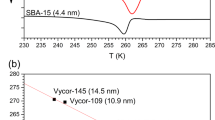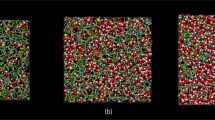Abstract
Water molecules confined in the interlayer region of calcium silicate hydrate (C–S–H) are closely related to the cohesion in the cementitious materials. In this research, molecular dynamics is employed to investigate the structure, dynamics and mechanical properties of water molecules in the nanopore of C–S–H gels at ambient temperature. In order to consider the confinement effect of calcium silicate sheets, the pore size expressed as interlayer distance changes from 13 to 22 Å. The water molecules near the C–S–H surface are strongly influenced by the ONB atoms in the silicate chains and Caw atoms in the interlayer region. They demonstrate following structural features: layering in the water density profile, the orientation preference in the dipolar angle distribution and long special correlation in the radial distribution function. Dynamically, while the interlayer distance increases by 10 Å, the diffusion coefficient transfers through two orders of magnitude from 3.42 × 10−12 to 5.3 × 10−10 m2/s2. In the mean square displacement curves, the cage stage, a characteristic of the dynamics in the glasses, gradually disappears with increasing interlayer distance. The dynamic evolution of water molecules is primarily induced by the changes in the strength of H-bonds and Ca–Ow connections, which is consistent with lowering of the frequency in the simulated vibration spectrum. The strongly attractive interaction between water molecules and calcium silicate layer is weakened and the motion of water molecules is less restricted at large interlayer distance. Furthermore, the interlayer fluid pressure study shows that the cohesion in the C–S–H gel, contributed by the interlayer calcium atoms, progressively diminishes from 1.5 to 0 GPa, due to the enhancing disjoining effect of water molecules connected with calcium atoms with increasing interlayer distance.













Similar content being viewed by others
References
Bonnaud PA, Ji Q, Coasne B, Pellenq RJ-M, Van Vliet KJ (2012) Thermodynamics of water confined in porous calcium–silicate–hydrates. Langmuir 28:11422–11432
Bordallo HN, Aldridge LP, Desmedt A (2006) Water dynamics in hardened ordinary Portland cement paste or concrete: from quasielastic neutron scattering. J Phys Chem B 110:17966–17976
Chen JJ, Thomas JJ, Taylor HFW, Jennings HM (2004) Solubility and structure of calcium silicate hydrate. Cem Concr Res 34:1499–1519
Costantinides G, Ulm F (2004) The effect of two types of C–S–H on the elasticity of cement-based materials: result from nanoindentation and micromechanical modeling. Cem Concr Res 34(1):67–80
Gale JD (1997) Gulp: a computer program for the symmetry-adapted simulation of solid. J Chem Soc Faraday Trans 93(4):629–637
Greener J, Peemoeller H, Choi C, Holly R, Reardon EJ, Hansson CM, Pintar MM (2000) Monitoring of hydration of white cement paste with proton NMR spin–spin relaxation. J Am Ceram Soc 83(3):623–627
Hou D, Ma H, Li Z, Jin Z (2014a) Molecular simulation of “hydrolytic weakening”: a case study on silica. Acta Mater 80:264–277
Hou D, Ma H, Zhu Y, Li Z (2014b) Calcium silicate hydrate from dry to saturated state: structure, dynamics and mechanical properties. Acta Mater 67:81–94
Ji Q, Pellenq RJM, Van Vliet KJ (2012) Comparison of computational water models for simulation of calcium silicate hydrate. Comput Mater Sci 53:234–240
Kerisit S, Liu CX (2009) Molecular simulation of water and ion diffusion in nanosized mineral fractures. Environ Sci Technol 43:777–782
Kirkpatrick RJ, Kalinichev AG, Wang J, Hou X, Amonette JE (2005) Molecular modeling of the vibrational spectra of interlayer and surface species of layered double hydroxides. CMS Workshop Lect 13:239
Kitadai N, Sawai T, Tonoue R, Nakashima S, Katsura M, Fukushi K (2014) Effects of ions on the OH stretching band of water as revealed by ATR-IR spectroscopy. J Solut Chem 43(6):1055–1077
Korb JP, Monteilhet L, McDonald PJ, Mitchell J (2007) Microstructure and texture of hydrated cement-based materials: a proton field cycling relaxometry approach. Cem Concr Res 37(3):295–302
Lee SH, Rossky PJ (1994) A comparison of the structure and dynamics of liquid water at hydrophobic and hydrophilic surfaces—a molecular dynamics simulation study. J Chem Phys 100(4):3334–3345
Li Z (2011) Advanced concrete technology. Wiley, Hoboken
Ma H, Li Z (2013) Realistic pore structure of Portland cement paste: experimental study and numerical simulation. Comput Concr 11(4):317–336
Ma H, Hou D, Liu J, Li Z (2014) Estimate the relative electrical conductivity of C–S–H gel from experimental results. Constr Build Mater 71:392–396
Manzano H, Moeini S, Marinelli F, van Duin A, Ulm F, Pellenq R (2011) Confined water dissociation in microporous defective silicates: mechanism, dipole distribution, and impact on substrate properties. J Am Chem Soc 134(4):2208–2215
Manzano H, Pellenq R, Ulm F, Buehler M (2012) Hydration of calcium oxide surface predicted by reactive force field molecular dynamics. Langmuir 28:4187–4197
Pellenq R, Kushima A, Shahsavari R, Van Vliet KJ, Buehler MJ, Yip S (2009) A realistic molecular model of cement hydrates. Proc Natl Acad Sci 106(38):16102–16107
Plimpton S (1995) Fast parallel algorithms for short-range molecular dynamics. J Comput Phys 117(1):1–19
Plimpton S, Thompson A, Crozier P, Kohlmeyer A (2001) LAMMPS molecular dynamics simulator. http://lammps.sandia.gov/index.html. Accessed 18 Jan 2014
Praprotnik M, Janezic D, Mavri J (2004) Temperature dependence of water vibrational spectrum: a molecular dynamics simulation study. J Phys Chem A 108(50):11056–11062
Puibasset J, Pellenq R (2008) Grand canonical Monte Carlo simulation study of water adsorption in silicalite at 300 K. Phys Chem B 112(20):6390–6397
Qomi MJA, Bauchy M, Ulm FJ, Pellenq RJM (2014) Anomalous composition-dependent dynamics of nanoconfined water in the interlayer of disordered calcium-silicates. J Chem Phys 140(5):054515
Rakiewicz EF, Benesi AJ, Grutzeck MW, Kwan S (1998) Determination of the state of water in hydrated cement phases using deuterium NMR spectroscopy. J Am Chem Soc 120(25):6415–6416
Selvam RP, Subramani VG, Murray S, Hall K (2009) Potential application of nanotechnology on cement based materials. Project Report MBTC DOT 2095/3004
Shahsavari R (2011) Hierarchical modeling of structure and mechanics of cement hydrate. PhD thesis of Massachusetts Institute of Technology
Shahsavari R, Pellenq RJM, Ulm FJ (2011) Empirical force fields for complex hydrated calcio-silicate layered materials. Phys Chem Chem Phy 13(3):1002–1011
Wang PS, Ferguson MM, Eng G, Bentz DP, Ferraris CF, Clifton JR (1998) 1H nuclear magnetic resonance characterization of Portland cement: molecular diffusion of water studied by spin relaxation and relaxation time-weighted imaging. J Mater Sci 33:3065–3071
Wang JW, Kalinichev AG, Kirkpatrick RJ (2004) Molecular modeling of water structure in nano-pores between brucite (001) surfaces. Geochim Cosmochim Acta 68(16):3351–3365
Youssef M, Pellenq RJM, Yildiz B (2011) Glassy nature of water in an ultraconfining disordered material: the case of calcium silicate hydrate. J Am Chem Soc 133:2499–2510
Yu P, Kirkpatrick RJ, Poe B, McMillan PF, Cong X (1999) Structure of calcium silicate hydrate (C–S–H): near-, mid-, and far-infrared spectroscopy. J Am Ceram Soc 82(3):742–748
Acknowledgments
Technical support from the Lammps and GULP softwares, financial support from the China Ministry of Science and Technology under Grant 2015CB655100, Shandong Provincial Natural Science Foundation under Grant 2014ZRB01AE4 and National Natural science foundation of China under Grant 51508292 are gratefully acknowledged.
Author information
Authors and Affiliations
Corresponding author
Rights and permissions
About this article
Cite this article
Hou, D., Lu, C., Zhao, T. et al. Structural, dynamic and mechanical evolution of water confined in the nanopores of disordered calcium silicate sheets. Microfluid Nanofluid 19, 1309–1323 (2015). https://doi.org/10.1007/s10404-015-1646-5
Received:
Accepted:
Published:
Issue Date:
DOI: https://doi.org/10.1007/s10404-015-1646-5




